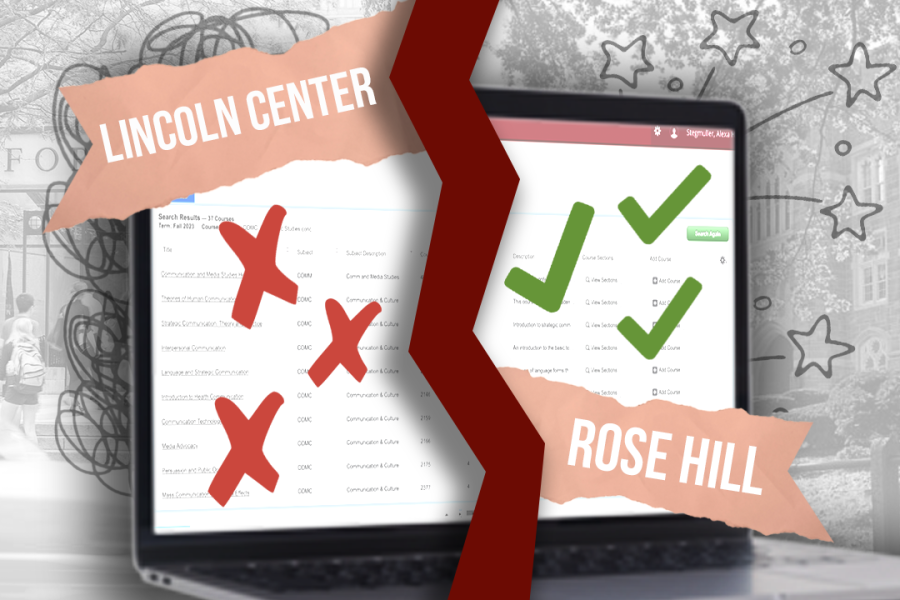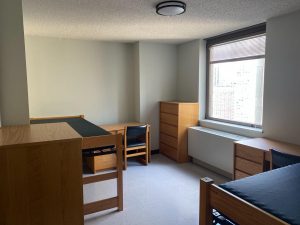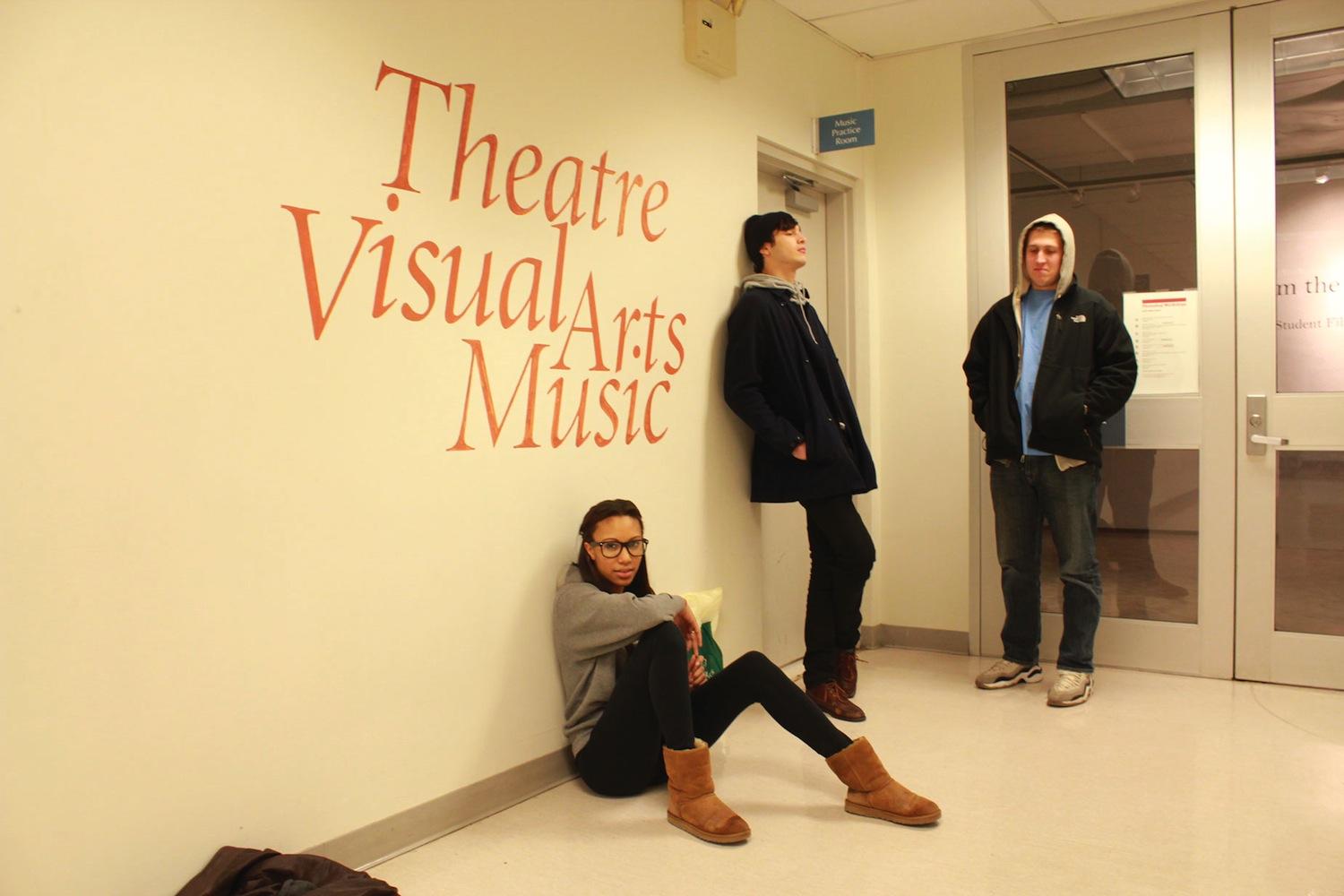Equal Resources for All?
A look at the uneven distribution of resources at Fordham University
March 22, 2023
Fordham University operates two distinct campuses for undergraduate students: Rose Hill and Lincoln Center. However, instead of working together as one cohesive university, each campus operates independently with its own administration, faculty and student body. This has led to the campuses occasionally functioning as completely different schools, with some Lincoln Center students feeling as though they are second-class citizens within the institution.
There are many disparities between the Fordham campuses, such as the campus dining options, which can force students to spend more money on subpar meals. Despite having the same food provider, Rose Hill offers a greater variety of dining options with longer hours than Lincoln Center. Another area for improvement is the stark differences in housing opportunities between the two campuses. This has resulted in some Lincoln Center students receiving housing assignments at Rose Hill because their home campus cannot handle the number of residents it has. Those lucky enough to be given living space at the campus they attend often encounter overcrowded dorms with forced double and triple bedrooms.
Rose Hill students are met with resources such as newly renovated buildings and more class offerings, while Lincoln Center students receive little in comparison. Some students at the Lincoln Center campus struggle to find the same course offerings, housing and extracurricular activities as their counterparts at Rose Hill. In addition, there is the issue of class registration. The lack of course offerings at Lincoln Center often leads to competition and anxiety when creating an academic schedule. I’m sure we’ve all had at least one conversation this semester lamenting how difficult it was to create a course schedule with useful and interesting classes at different times, and now at the Lincoln Center campus, many of us are paying the price.
When asked about the disparity in course offerings, Laura Auricchio, dean of Fordham College at Lincoln Center, said, “the short answer is that, because there are more students at FCRH, there are more course offerings at FCRH.”
Despite Rose Hill being a larger campus with more students to fill classes, this does not justify a deficiency in course offerings for Lincoln Center students. According to Fordham’s course catalog, only three microeconomics classes were offered at Lincoln Center for the spring 2023 semester, but 14 were offered at Rose Hill. Additionally, there were only 10 political science electives at Lincoln Center for the spring 2023 semester, compared to the 25 offered at Rose Hill.
When registering for classes, I found that all 35 seats for each microeconomics class at Lincoln Center were already full, whereas most of the Rose Hill classes still had several open seats. While it is true that there are more students at Rose Hill and that the campus needs more classes, Lincoln Center’s needs are clearly not being met while Rose Hill is given an excess of courses.
This issue can have ripple effects impacting a student’s overall college experience and ability to be successful in their college career. For instance, small class sizes, which are generally seen as a positive, have turned into a source of inconvenience, class congestion and student frustration for students at Fordham. Additionally, due to Fordham’s course disparity and class congestion, Lincoln Center students often have no choice but to commute to the other campus to take required classes that their own campus lacks.
Although I agree with Auricchio when she notes that the “change initiated in 2020 has considerably expanded the number of courses available to both FCLC and FCRH campus,” it is important to remember that all students pay around the same price to attend either campus, despite this unequal distribution of resources.
The 30-60 minute Ram Van ride to classes can be frustrating for students who live on campus, but it can be even more difficult for commuter students. Those from Brooklyn, Queens and Staten Island, who may have chosen the Lincoln Center campus for its proximity, now find themselves having to wake up even earlier to attend an 8:30 a.m. class in the Bronx simply because the course they are required to take is only offered at that time and location.
To top it off, Fordham doesn’t offer free Ram Van passes for commuter students if they only take courses at one campus, which has become more frequent due to limited course options. This means that if you are a Lincoln Center student but all of the classes you need to take in a given semester are at Rose Hill, you would have to take public transit to the Bronx or pay $3.50 per ride on the Ram Van.
Although I agree with Auricchio when she notes that the “change initiated in 2020 has considerably expanded the number of courses available to both FCLC and FCRH campus,” it is important to remember that all students pay around the same price to attend either campus, despite this unequal distribution of resources. For the amount that people pay to attend Fordham, which is set to increase by 6% next year (a total of 9% since I was a freshman), commuting to Rose Hill should be a choice, not an obligation.
In fact, Lincoln Center students rarely have the opportunity to interact with their university leadership.
There is a disconnect between the process of allocating courses that are offered for the fall and the spring and the amount of courses needed for the Lincoln Center campus. These are a few potential solutions that come to my mind when thinking about how to mend the connection. I’m just spitballing here, but the university could conduct a needs assessment to identify the specific needs and challenges faced by students on each campus, engage in dialogue with students to ensure their needs and concerns are taken into account during the decision-making process, seek external funding to support specific initiatives or projects on one campus or the other, and consider redistributing existing resources to areas where they are needed more.
This kind of attention seems unlikely when even the university’s top officials are absent from Lincoln Center for extended periods. In fact, Lincoln Center students rarely have the opportunity to interact with their university leadership. Perhaps by increasing the presence of university leadership at Lincoln Center and involving them in the needs assessment and decision-making processes, the Lincoln Center campus can receive the care and attention it has been lacking. Only then will students stop feeling like second-class citizens at their own university.
















